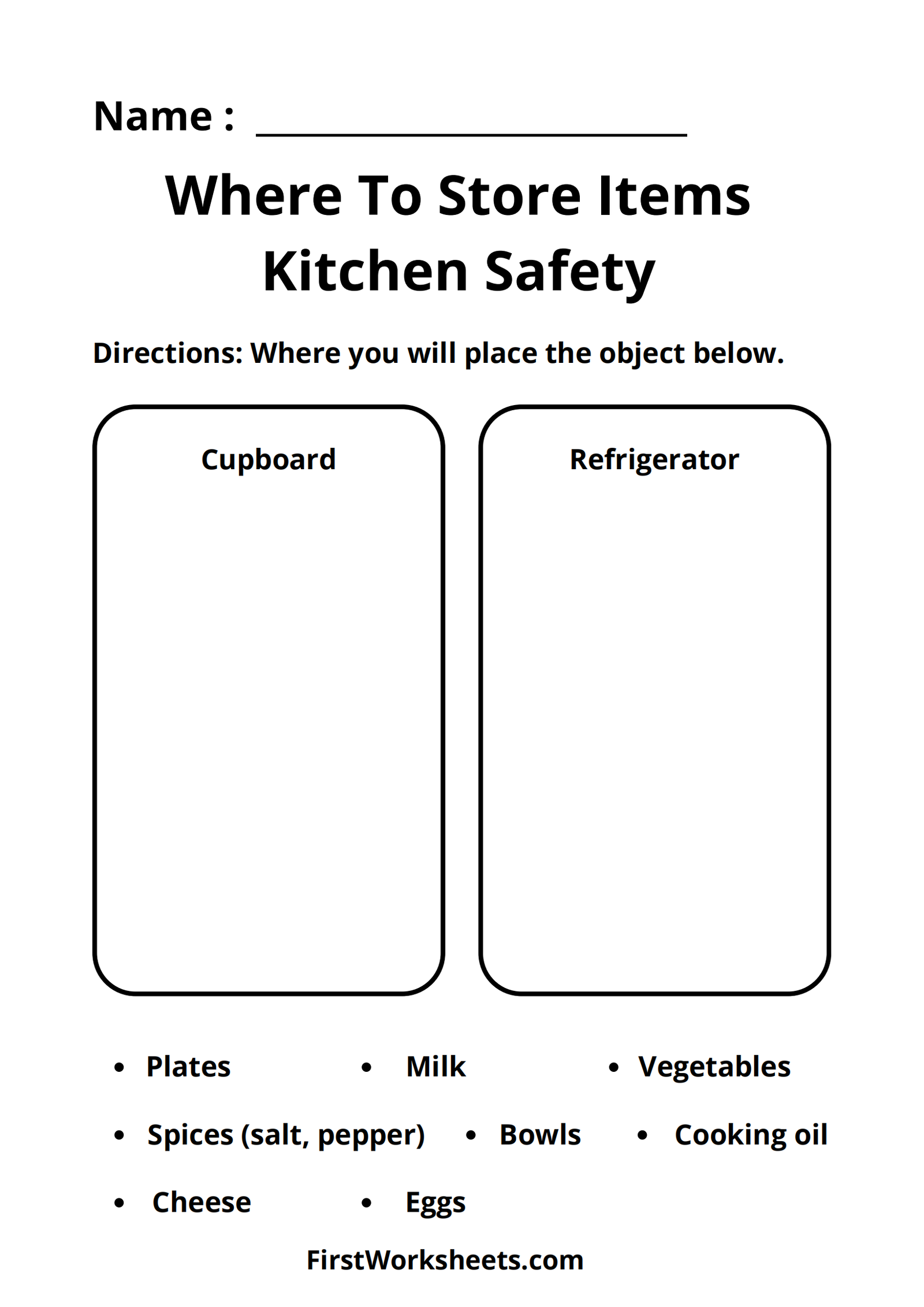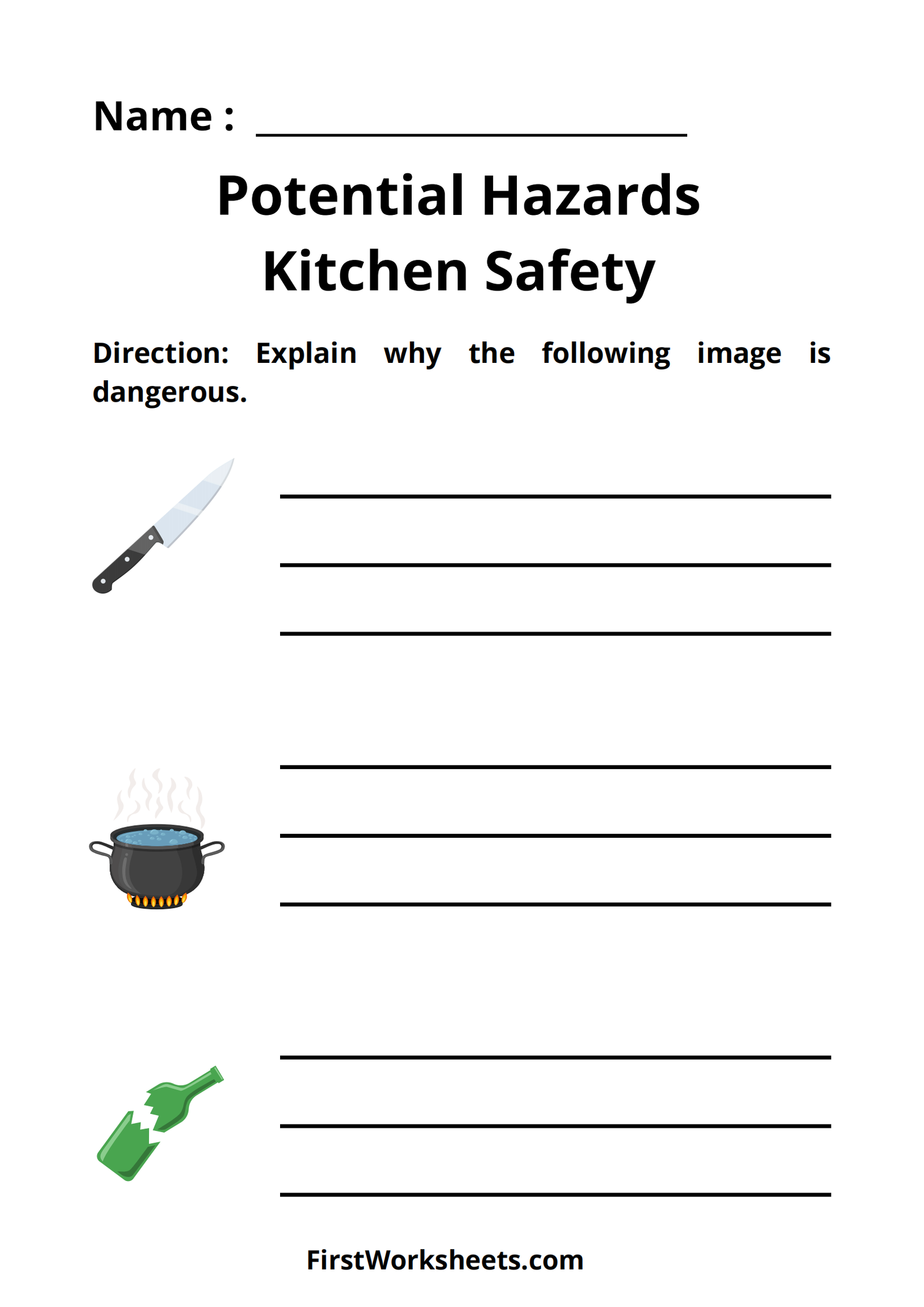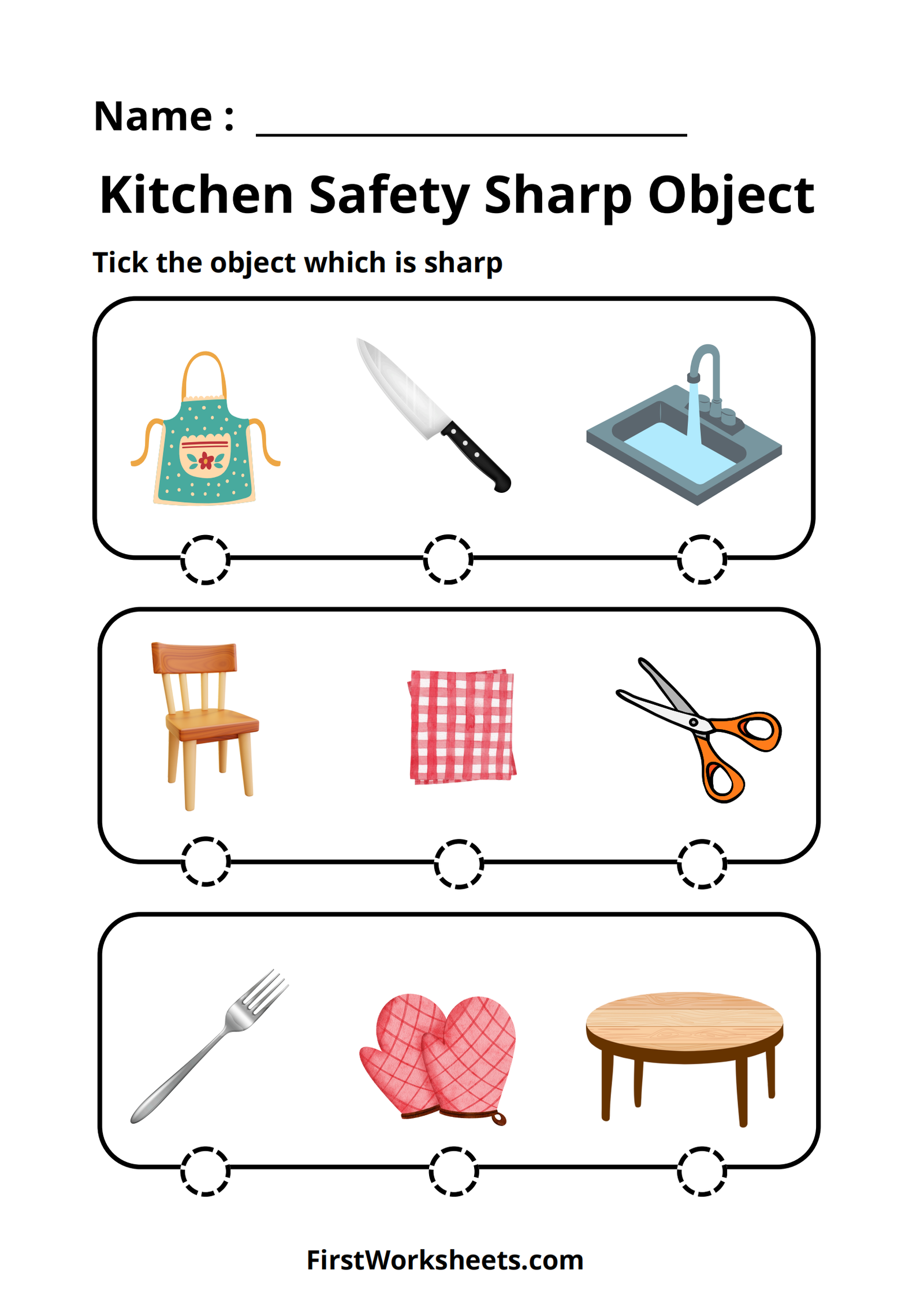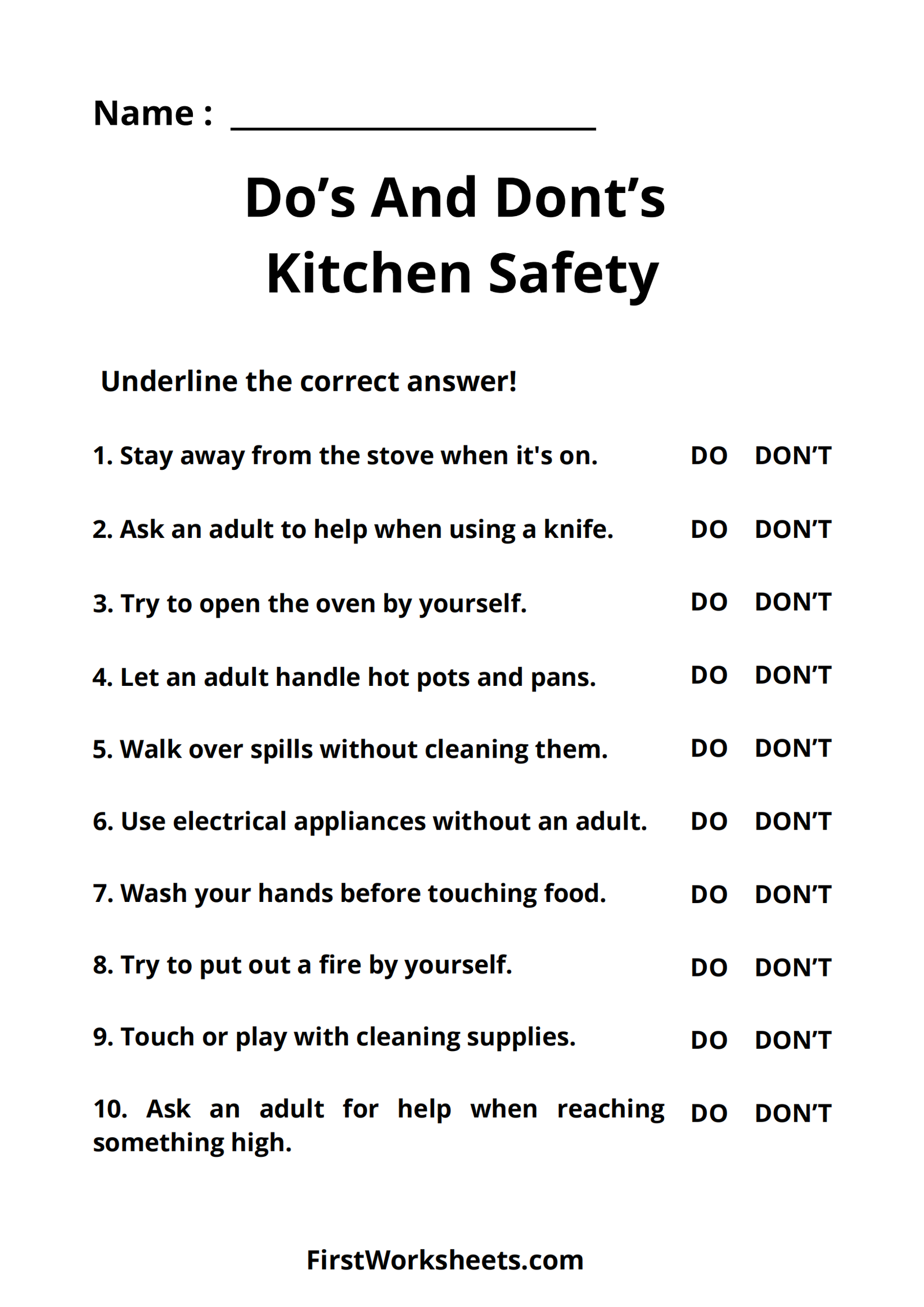Kitchen Safety Worksheets
Kitchen safety worksheets for kids are educational tools designed to teach children important safety principles in the kitchen. These worksheets focus on making children aware of potential hazards in a kitchen environment, how to handle kitchen equipment safely, and the importance of maintaining hygiene. The content and design of these worksheets are tailored to be engaging and age-appropriate, ensuring that the lessons are both informative and interesting for kids.
Key Focus Areas of Kitchen Safety Worksheets
- Identifying Hazards:
- Worksheets often include images or scenarios where kids have to identify potential dangers. Examples include sharp knives, hot stovetops, electrical appliances, and slippery floors.
- Activities may involve circling or coloring unsafe items in a kitchen scene, or matching pictures of hazards with their safety precautions.
- Proper Use of Kitchen Tools:
- These worksheets introduce children to various kitchen utensils like knives, peelers, graters, and more, teaching the correct way to use each tool.
- Instructions on how to carry a knife, keep fingers safe while cutting, or using a peeler safely are often highlighted.
- Some worksheets use matching exercises, where kids pair a tool with its correct use or function.
- Hygiene and Cleanliness:
- A major aspect of kitchen safety is maintaining cleanliness to prevent foodborne illnesses. Worksheets may emphasize washing hands before handling food, cleaning surfaces, and proper food storage.
- Activities might include coloring sheets that show when to wash hands, or sorting tasks where kids decide which foods need refrigeration and which don’t.
- Fire and Heat Safety:
- Children learn how to avoid burns and fires, with emphasis on staying away from hot surfaces like stoves, ovens, and toasters.
- Worksheets often contain illustrations showing safe distances from heat sources or what to do if a small fire starts (e.g., covering a pan fire).
- They might also include scenarios that ask kids to choose the correct action if they encounter a fire hazard.
- Handling Food Safely:
- These worksheets teach kids about the importance of avoiding cross-contamination, keeping raw and cooked foods separate, and properly washing fruits and vegetables.
- Some activities could include arranging foods on a refrigerator shelf in the correct order to prevent cross-contamination or identifying which foods require special handling (like raw chicken).
- Emergency Procedures:
- In case of accidents, it’s crucial for kids to know basic first-aid measures and when to call for help. Worksheets might include simple instructions for treating minor burns or cuts, or activities that involve dialing emergency numbers.
- Scenarios may be included where kids determine the right course of action (e.g., if they accidentally cut themselves or encounter a kitchen fire).
Types of Activities in Kitchen Safety Worksheets
- Coloring Pages:
- These pages make learning fun and allow younger children to recognize safety tools and situations visually. For example, kids might color pictures of people washing their hands or using oven mitts.
- Coloring activities can be paired with simple captions that reinforce the safety message.
- Matching Games:
- Worksheets might have matching exercises where kids draw lines between a kitchen hazard (e.g., a hot stove) and the safety measure (e.g., using a pot holder).
- These activities are great for reinforcing knowledge and understanding the connection between actions and outcomes.
- True or False Statements:
- A list of statements about kitchen safety can be included, and kids need to determine whether each statement is true or false.
- For example, a statement might read, “It’s safe to touch a hot pan without a glove,” and kids would mark it as false. This helps reinforce correct safety practices.
- Crossword Puzzles and Word Searches:
- These worksheets can be used to introduce kitchen safety vocabulary such as “apron,” “knife,” “oven mitt,” and “fire extinguisher.”
- They are particularly helpful for older kids who are ready for more challenging activities and want to learn the terms associated with kitchen safety.
- Scenario-based Questions:
- Worksheets might include short story scenarios that depict various kitchen situations. Kids are asked to choose the safest course of action or identify what went wrong in the scenario.
- This type of exercise helps kids think critically about safety in real-world contexts.
Benefits of Kitchen Safety Worksheets for Kids
- Engages Young Learners:
- By using pictures, games, and interactive exercises, worksheets hold children’s attention while teaching valuable lessons.
- They break down potentially complex safety instructions into bite-sized, kid-friendly information.
- Encourages Hands-On Learning:
- Kitchen safety worksheets are often used alongside supervised kitchen activities, allowing kids to apply what they’ve learned in real situations.
- For example, after completing a worksheet about handling knives safely, kids might practice slicing soft fruits with supervision.
- Builds Confidence in the Kitchen:
- Learning the basics of kitchen safety helps children feel more confident and capable when helping out with cooking or other kitchen tasks.
- This confidence can translate into a greater interest in cooking and preparing food, fostering independence and life skills.
- Reinforces Safety Awareness:
- Repeated practice through worksheets helps children remember safety rules more effectively.
- By discussing and working through different safety scenarios, kids become more aware of risks and how to navigate them safely.
- Supports Family Education:
- Kitchen safety worksheets can be a valuable tool for parents, teachers, or caregivers who want to instill safe habits in children.
- They can serve as conversation starters about safe behaviors and foster a family culture of safety in the kitchen.
Age-Appropriate Adaptations
- For Younger Children (Ages 4-7): Worksheets focus on simple concepts like washing hands, recognizing hot objects, and using child-friendly tools like plastic knives. The activities involve more coloring and basic matching exercises.
- For Older Children (Ages 8-12): These worksheets include more detailed explanations of safe food handling, specific instructions on using appliances, and activities like word searches or scenario-based questions that require critical thinking.
By introducing children to kitchen safety in a structured and engaging manner, these worksheets provide a solid foundation that prepares kids for a safe and enjoyable experience in the kitchen.





